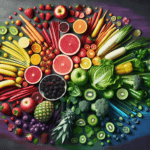So, you’ve decided to embark on an extended fasting journey and want to make the most of it. Well, look no further! In this article, we will explore the best ways you can incorporate mindfulness and meditation into your fasting routine to enhance the physical, mental, and spiritual benefits of this experience. From simple deep-breathing exercises to guided meditations specifically designed for fasting, we’ve got you covered. Get ready to discover a whole new level of self-awareness and inner peace as you nourish your body and mind through this transformative process.
Prepare Your Mind and Body
Before embarking on an extended fasting journey, it’s crucial to prepare both your mind and body. Fasting can be a transformative experience, and setting the right intentions will help you make the most out of it.
Set Intentions
Start by clarifying why you want to undertake an extended fast. Whether it’s for physical detoxification, mental clarity, or spiritual growth, having clear intentions will keep you focused throughout the process. Write down your intentions and remind yourself of them regularly.
Clear Your Schedule
To fully immerse yourself in fasting and meditation, it’s important to clear your schedule as much as possible. Inform your loved ones, coworkers, and friends about your fasting plans and let them know that you may need some quiet time. Minimizing external commitments will create a space for you to truly dive into your fasting journey.
Hydrate Properly
Staying hydrated is crucial during fasting, as it supports your body’s detoxification processes and helps curb hunger pangs. Before starting your fast, make sure to drink plenty of water and keep hydrating throughout the day. Herbal teas and electrolyte-rich beverages can also be included to replenish essential minerals.
Create a Quiet and Sacred Space
Creating a calm and sacred space will enhance your fasting and meditation practice. Find a spot in your home or outdoors where you can retreat to and create a serene atmosphere.
Find a Peaceful Spot
Choose a location that resonates with you, whether it’s a corner in your living room, a cozy nook in your garden, or a secluded spot in nature. This dedicated space will become your sanctuary during fasting and meditation, allowing for tranquility and focus.
Remove Distractions
Eliminating distractions is essential to fully engage in your fasting practice. Turn off your cell phone or put it on silent mode to prevent interruptions. If you’re practicing at home, let your family members know that you’ll need some uninterrupted time. Create boundaries and ensure a distraction-free environment.
Set the Mood
Creating the right ambiance will help you enter a relaxed state of mind. Use soft lighting or candles to create a warm and calm atmosphere. Play gentle instrumental music or nature sounds in the background to enhance the serenity of your space. Consider incorporating aromatherapy by using essential oils like lavender, chamomile, or frankincense to promote relaxation.
Choose Your Meditation Technique
Meditation is a powerful tool to complement your fasting journey, allowing you to cultivate deep awareness and inner peace. There are several meditation techniques to choose from; here are a few popular ones.
Breathing Meditation
Focus your attention on your breath, observing its natural rhythm. Take slow, deep breaths in and out, allowing your breath to anchor your awareness in the present moment. Notice the sensation of air entering and leaving your body, bringing your focus back whenever your mind wanders.
Body Scan Meditation
In body scan meditation, you systematically direct your attention to different parts of your body, starting from your toes and moving upward. Notice any sensations, tension, or discomfort and practice non-judgmental awareness. This technique helps you develop a strong mind-body connection and release tension from within.
Loving Kindness Meditation
Loving kindness meditation involves cultivating compassion and empathy towards yourself and others. Begin by sending loving and kind thoughts to yourself, then extend them to loved ones, acquaintances, and even to people you may have difficulties with. This practice cultivates feelings of love and connectedness, benefiting both your inner well-being and your relationships.
Practice Mindful Eating
When it’s time to break your fast, practicing mindful eating promotes a deep connection with your food, nourishing not just your body but also your soul.
Eat Slowly and Mindfully
Take the time to savor each bite, chewing slowly and consciously. Pay attention to the flavors, textures, and aromas of your food. This mindfulness allows you to fully experience the nourishment and pleasure of eating. Avoid distractions like watching TV or scrolling through your phone while eating.
Observe Sensations and Flavors
While eating, maintain awareness of the sensations in your body. Notice how hunger diminishes and satisfaction arises. Observe the taste buds on your tongue perceiving sweet, salty, sour, or bitter flavors. Eating with mindfulness not only enhances your nutritional absorption but also fosters gratitude and contentment.
Express Gratitude
Before and after your meal, take a moment to express gratitude for the nourishment you are about to receive and the experience of eating. Acknowledge the effort that went into producing and preparing your food. This practice shifts your mindset from mere consumption to deep appreciation for the sustenance provided by nature and others.
Engage in Gentle Movements
Incorporating gentle movements into your fasting routine enhances both physical and mental well-being. These exercises promote circulation, flexibility, and a sense of grounding.
Yoga or Stretching
Engage in a gentle yoga or stretching routine to awaken your body and bring flexibility to your muscles and joints. Focus on slow and mindful movements, allowing your breath to guide each posture. Yoga postures help release tension, increase blood flow, and encourage a sense of calmness.
Walking Meditation
Combine the benefits of meditation and physical movement by practicing walking meditation. Find a peaceful outdoor location and walk slowly, placing your attention on the sensations in your feet, legs, and body as they move. Be aware of the shifting of weight, the touch of your feet on the ground, and the connection with nature.
Qi Gong or Tai Chi
Qi Gong and Tai Chi are ancient practices that cultivate energy flow, balance, and relaxation. These gentle movements involve coordinated breathwork, slow and deliberate postures, and a focus on cultivating inner energy. Engaging in these practices during fasting supports the harmonization of mind, body, and spirit.
Cultivate Awareness in Everyday Activities
Mindfulness is not limited to formal meditation sessions; it can be integrated into your daily activities, allowing you to live each moment with heightened awareness and presence.
Mindful Washing and Brushing
Transform routine activities like washing your hands or brushing your teeth into mindful moments. Notice the sensations of the water, the texture of soap, or the repetitive motion of brushing. By bringing full awareness to these activities, you bring mindfulness into your everyday life.
Conscious Listening
When engaging in conversations or listening to music, make a conscious effort to truly listen. Focus your attention on the words being spoken or the melodies and harmonies of the music. Practicing active listening cultivates deep connections and understanding with others while sharpening your ability to be present.
Taking Mindful Breaks
Throughout the day, take short breaks to pause, breathe, and bring awareness to the present moment. This can be as simple as taking a few conscious breaths or stepping outside to connect with nature. These mindful breaks serve as resets, allowing you to return to your tasks with renewed focus and clarity.
Use Guided Meditations and Apps
Guided meditations and meditation apps are valuable resources to support your fasting and meditation practice, especially if you’re new to meditation or seeking variety in your sessions.
Listen to Guided Meditations
Guided meditations provide verbal guidance, taking you through different meditation techniques and helping you stay focused. Many guided meditations are available online and cover various durations and themes, allowing you to choose what resonates with your needs. Listen to these recordings during your meditation sessions to deepen your practice.
Try Meditation Apps
Meditation apps offer a convenient way to access guided meditations and track your progress. They often include features like customizable timer settings, daily reminders, and a variety of meditation teachers to choose from. Explore different apps to find one that aligns with your preferences and supports your fasting journey.
Join Online Meditation Communities
Online meditation communities provide virtual spaces to connect with like-minded individuals on the path of mindfulness and meditation. Joining these communities fosters a sense of belonging and provides opportunities for group meditations, discussions, and sharing experiences. Engaging with others who share similar interests and goals can be inspiring and enriching.
Practice Mental Visualization
Mental visualization is a powerful technique to enhance relaxation, focus, and intention-setting during fasting and meditation. By engaging your mind’s eye, you can tap into the power of imagination and create profound healing experiences.
Create Mental Imagery
Close your eyes and visualize serene landscapes, beautiful scenes, or cherished memories. Allow your imagination to create vivid details, engaging all your senses. This mental imagery can transport you to a peaceful and calming inner space, facilitating deep relaxation and tranquility.
Visualize Nourishment
During fasting, visualizing nourishing foods or drinks can satisfy cravings or feelings of hunger. Imagine the aroma, taste, and texture of your favorite healthy meals. Visualizing nourishment fosters a connection with the essence of food and nourishment, supporting your fasting journey with a sense of fulfillment and satisfaction.
Imagine a Healing Light
While meditating, imagine a healing light surrounding your body and permeating every cell. Visualize this light bringing healing, rejuvenation, and balance to your physical, emotional, and spiritual aspects. This visualization can be a powerful tool for self-healing and transformation during extended fasting.
Embrace Nature and Outdoor Meditation
Connecting with nature is a profound way to deepen your fasting and meditation practice. Spending time outdoors and immersing yourself in natural surroundings allows you to harmonize with the rhythms of the Earth, encouraging a sense of peace and groundedness.
Connect with Nature
Seek opportunities to spend time in nature, whether it’s walking in a park, sitting under a tree, or observing the beauty of a sunset. Cultivate a sense of awe and appreciation for the natural world, noticing the intricate details and the interconnectedness of all living beings.
Practice Walking or Sitting Outdoors
Take your meditation practice outside by practicing walking or sitting meditation in nature. Find a peaceful spot, whether it’s a forest, a beach, or a meadow, and allow the surroundings to support your meditation. Connect with the earth beneath your feet and the gentle breeze against your skin as you cultivate mindfulness in the embrace of nature.
Observe Natural Elements
During your outdoor meditation or nature walks, practice observing and appreciating the natural elements around you. Pay attention to the colors and shapes of flowers, the sound of birdsong, the scent of pine or wildflowers, and the feeling of soft grass beneath your fingertips. These sensory experiences deepen your connection with the present moment and the beauty of the natural world.
Journaling and Reflection
Incorporating journaling and reflection into your fasting journey provides an outlet to express your thoughts, emotions, and insights, deepening your self-awareness and aiding in personal growth.
Reflect on Your Fasting Experience
Dedicate time each day to reflect on your fasting experience. Explore how your body, mind, and emotions respond to the process. Reflect on any physical sensations, changes in appetite, or mental clarity you may be experiencing. Acknowledge any challenges or breakthroughs, allowing yourself to embrace the lessons fasting brings forth.
Write Down Thoughts and Emotions
Journaling is a therapeutic practice that allows for self-expression and emotional release. Write down your thoughts, feelings, and emotions as they arise during your fasting and meditation practice. This can provide a sense of clarity and insight into your inner world, facilitating personal growth and self-discovery.
Set Daily Intentions
Each day, before embarking on your fasting and meditation journey, set intentions for the day ahead. Write down what you hope to achieve, what qualities you wish to cultivate, or how you want to show up for yourself and others. This intentional focus brings mindfulness into your daily activities, helping you align with your purpose and cultivate the desired mental and emotional state.
Embarking on an extended fasting journey is an opportunity for personal growth, self-discovery, and inner transformation. By incorporating mindfulness and meditation into your fasting practice, you can deepen your connection with yourself, nourish your mind, body, and spirit, and cultivate a sense of peace and well-being. Remember to approach your journey with curiosity, patience, and self-compassion, allowing yourself to fully embrace the beauty and benefits of mindfulness and meditation during extended fasting.




